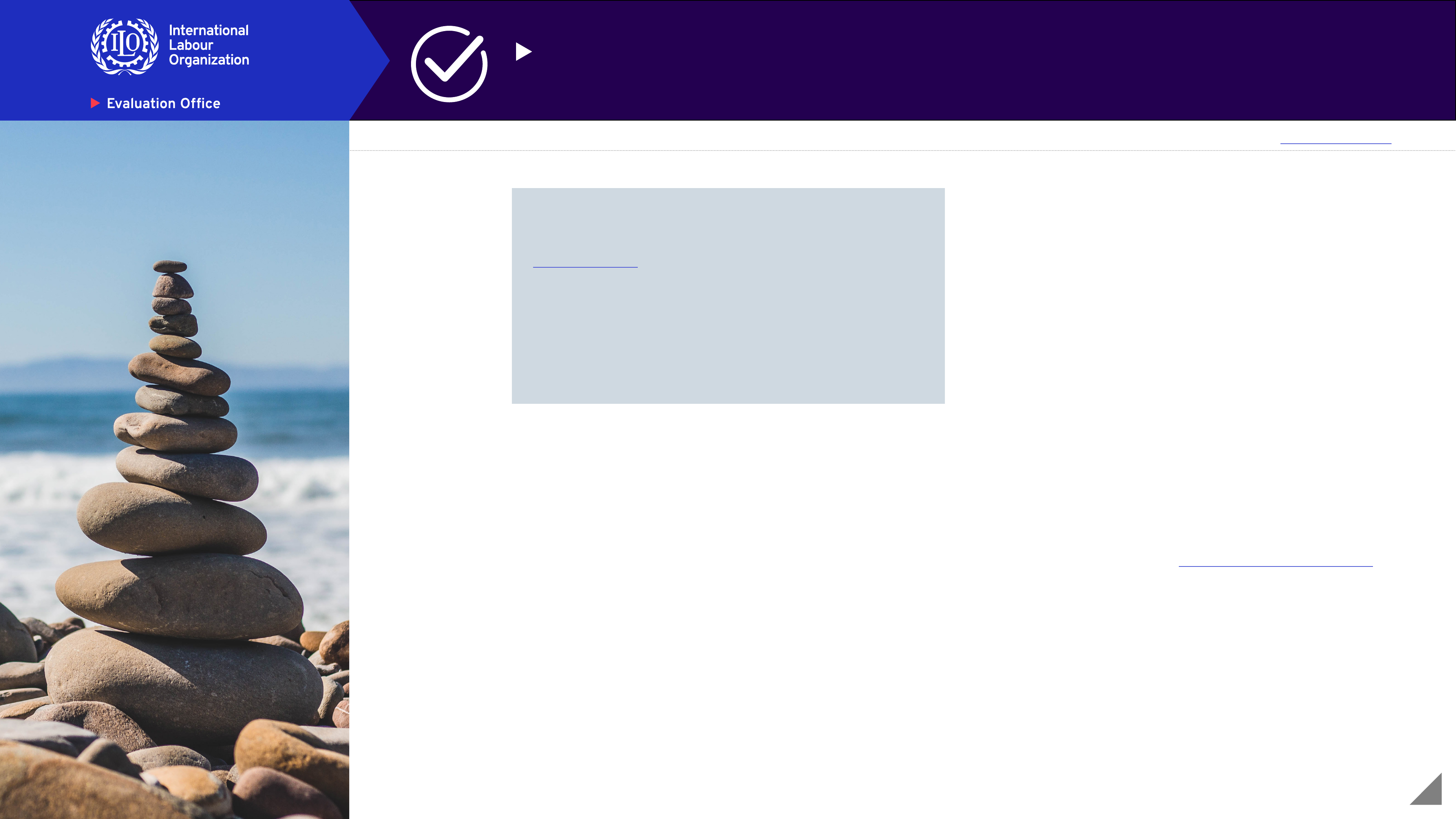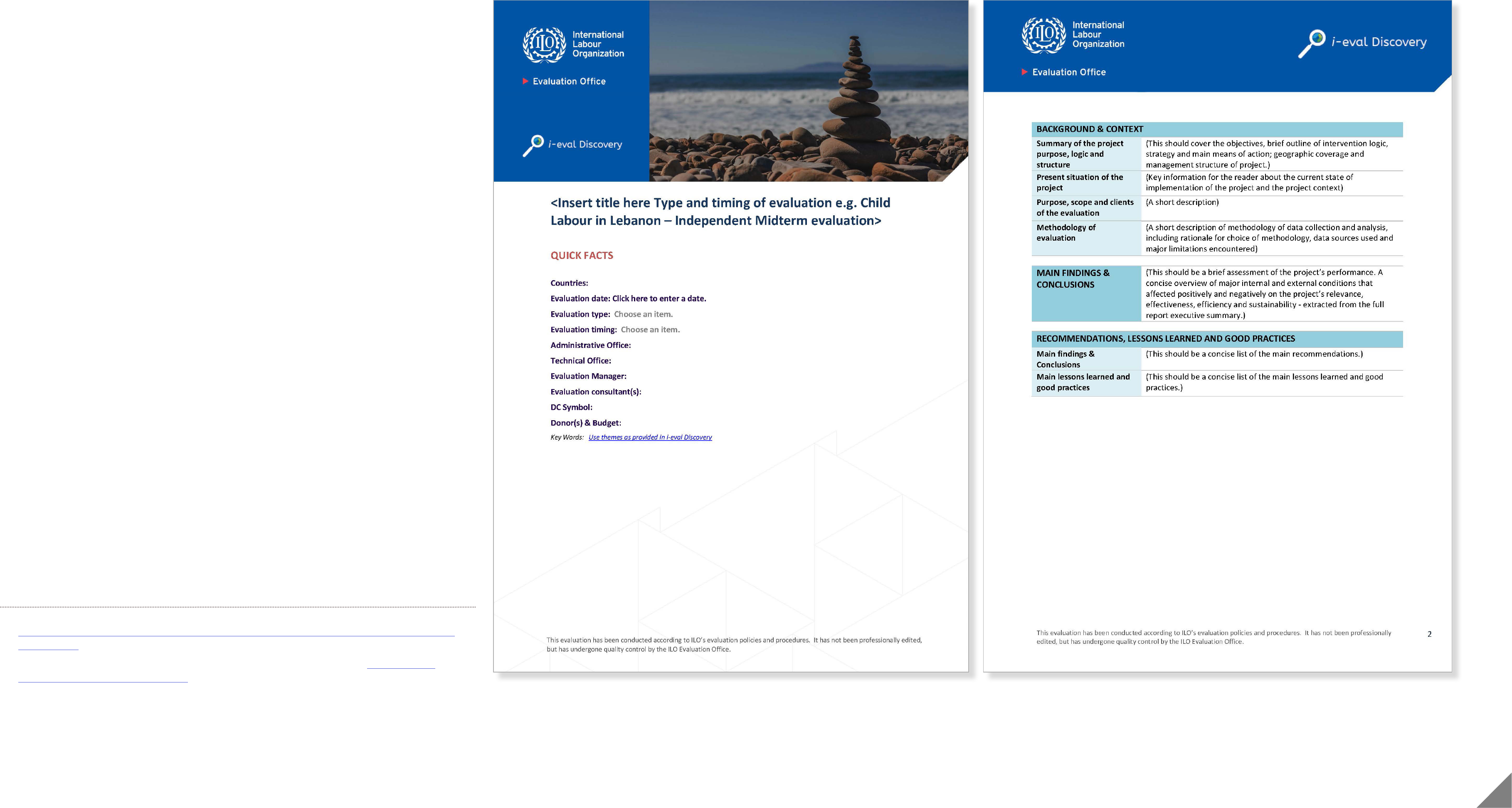
This checklist is to be read in conjunction with ‣ Guidance Note 4.1
1
Checklist 4.4: Preparing the Evaluation Report Summary
X Date: April 2021, v.2 (v.1 2012)
This guidance note is a living document and has not been professionally edited.
Right-click on hyperlinks and select ‘Open in new tab’ to access, if viewing in browser.
This checklist is meant to assist evaluation managers to
ensure that every independent evaluation report receives a
uniform evaluation summary for presentation to the public
in i-eval Discovery. This is completed by the evaluator and
should be limited to four pages. The information should be
precise, concise, and usually extracted from the evaluation
report’s executive summary. The evaluator must submit
the completed summary to the evaluation manager which
will then be available for download in i-eval Discovery.
Please click here to access the Word version to prepare the
evaluation report summary.
X 1. PURPOSE OF THE SUMMARY
• Transparency and knowledge sharing: Providing ILO
officials and the general public with an evaluation summary
facilitates uptake of evaluation information and generates
interest in the longer reports. These summaries are used only
for independent project evaluations. The summary plays a
critical role in that it is the most circulated information product
in evaluation and thereby the standard by which these are
completed directly reflects on ILO’s evaluation work.
• Structuring the executive summary of the main report:
EVAL recommends that the executive summary of the full
evaluation report keep the same structure as the template
summary presented here. Having this kind of consistency in
structure makes data collection for our annual Meta-analysis
of evaluation quality a more efficient and reliable process.
• Access to the template: EVAL uses a specific template for
project evaluation summaries so that they have a comparable
content and uniform look. The evaluation summary template
must be submitted in Word format and is available for
downloading on the EVAL website.

2
Checklist 4.4: Preparing the Evaluation Report Summary
X 3. BACKGROUND AND CONTEXT
• Summary of the project purpose, logic and structure: This
section should contain a few paragraphs presenting the
project objectives and a brief outline of intervention logic,
strategy and main means of action. This should include
information on geographic coverage and management
structure of project.
• Present situation of project: This is particularly of interest
for mid-term or interim reports but also applies to final
evaluation reports. If the project experienced special
environmental issues such as a natural disaster, armed
conflict or particular delays due to recruitment or personnel
issues, it can be mentioned here. In general this section is
meant to contain key information about the current state of
implementation of the project and the project context.
• Purpose, scope and clients of the evaluation: This would
be information taken from the Terms of Reference (TORs)
for the evaluation, presented in a brief paragraph. Relevant
information includes a brief outline of why the evaluation
is being conducted; who will use the information; what
information is needed and how it will be used; the time
period and geographical coverage; and the target groups or
beneficiaries to be included.
• Methodology of evaluation: This section is also drawn from
the evaluation TORs and should contain a short description
of methodology of data collection and analysis, including
rationale for choice of methodology, data sources used and
major limitations encountered.
X 2. QUICK FACTS
Countries: List all country/-ies covered by the project
Evaluation date: Date evaluation was approved by EVAL
Evaluation type: Project evaluation, RBSA-funded activity, Thematic evaluation, Joint project evaluation, Cluster
evaluation, External evaluation, etc.
ILO Administrative Oce: ILO oce that is responsible for administrating project, as specied in the PARDEV Approval Minute
ILO Technical Oce: ILO oce that is technically oce technically responsible for backstopping the project, as specied in
the PARDEV Approval Minute
Evaluation manager: This should be the name of the ocial who managed the evaluation. In the case of an externally-
managed joint evaluation, the lead agency would be listed here.
Evaluation consultant(s): List names of all consultants who worked on the evaluation. In the case of a team, the lead should be
identied along with the names of all team members.
ILO DC symbol: Indicate the DC symbol, as specied in the PARDEV Approval Minute (ex. INT/02/42/SWI.)
Donor & project budget: Name the donor and indicate the project budget in US$.
Keywords: This section should simply list the main themes as provided in i-eval Discovery

3
Checklist 4.4: Preparing the Evaluation Report Summary
X 4. MAIN FINDINGS AND CONCLUSIONS
This section, approximately one or two pages should present
a brief overall assessment of the project’s performance,
summarized from the full report. A concise overview of major
internal and external conditions that have positively and
negatively affected the project’s relevance, effectiveness,
eciency, impact and sustainability should be included.
X 5. RECOMMENDATIONS, LESSONS LEARNED AND
GOOD PRACTICES
• Main recommendations and follow-up: This section should
be a concise listing of the numbered recommendations taken
from the full report, not including the explanatory text. These
can be presented in bullet format, when appropriate.
1
• Lessons learned: These should be just the concise
statements taken from the main report.
2
• Good practices: These should be just the concise statements
taken from the main report.
1. More information on management response to recommendations can be found in
Guidance note 5.4 Management follow-up to recommendations from independent
evaluations.
2. More details on ILOs denition of lessons learned can be found in Checklist 4.2
Preparing the evaluation report.
